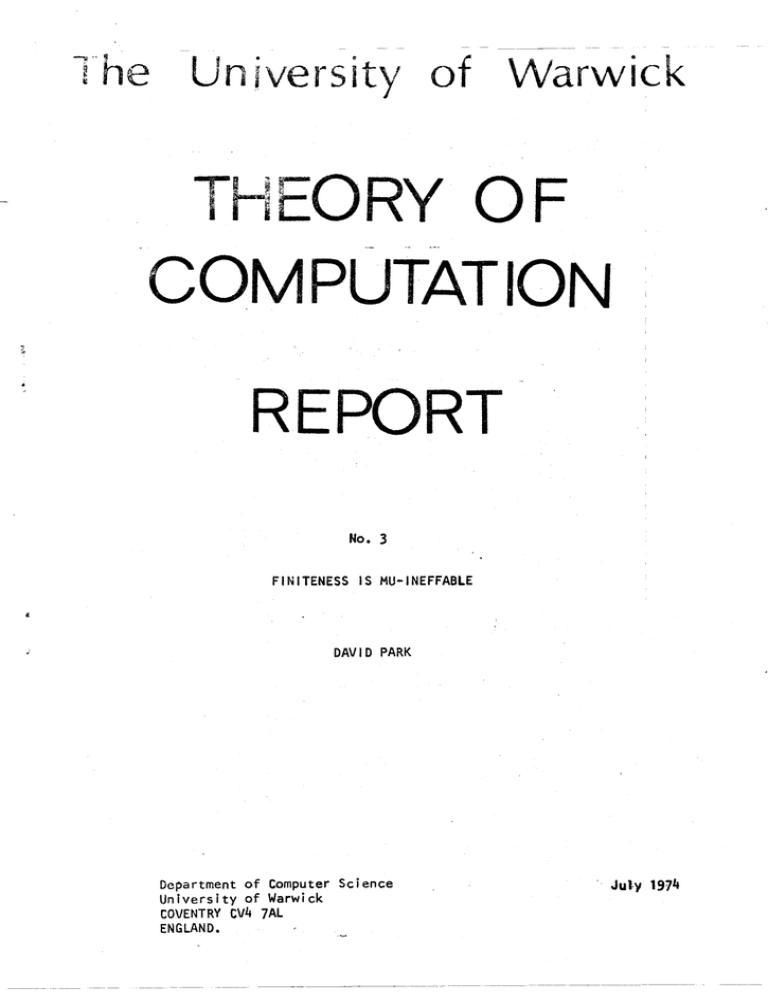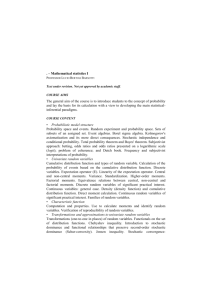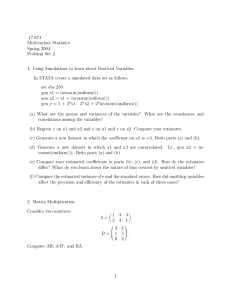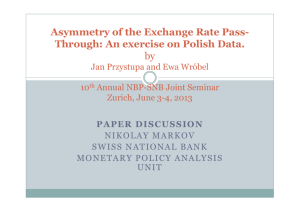of OF CONIPUTATON REPORT
advertisement

i $"re Univensity of
Warwick
Th$TORY OF
CONIPUTATON
REPORT
No.
3
FINITENESS IS MU-INEFFABLE
DAVID PARK
Dcpartment
of
University of
Computer
Warwick
COVENTRY CV4 7AL
ENGLAND.
Science
July
1974
iTfitirSS i 5 rlu- iN[-
F I t{
By
l.
DA\i
lD
FABLE
PARK
lntroduction
is a fonrrral system which arises fairly naturally
Theitmui-caiculusrr
when one
rries to
exeerrd pre*ica'ce
programs. Fi rst-order pred i cete
iogic
'log
'Lo forma!
ise arguments
ic by i tsei f is not
about
aciequate to
express !n'eerestlng asseri.ions about programs natural ly, even for the
most i irnitecl sorl"s
unsolvabi
programming 'language, as
of
lity i'esults of
l-uckham, Fark
cor*
&,*
\das-fj+t
6 Faterson I6 l.
seen from the
0n one view,
ri
,j+-Lsr+4-e+t, *l+s the "minimal
fixpoint operatorrrp, By acidlng such an oFerator to the classical
what
rs
re*
needed
to express
sulch things
primitives cf pred!cate iogic, it dtd
argurnents about progroms
enunciated principies
oecon.e
possibie to formaiise
many
iri a n!ce vua7, and tG see i",Eny Previously
for
reagon
lng ebo,.rt proErams as relyinE on the
pecuiiar features of this o*eraior {se*:, for exampie Park I I ]
,
deBakt<eraScotriZj),
'lne ceic,;ius rnat
l*rh.
a""i:3
vJG';r
L no, oh'viously "ciassicairt,
bE
in that i't.s expr*ss ive pohier {r.'-h.ci; i t **l*i+i say about mathemat i cal
J".s
+fe'tttV 1''
strrrctures) ,Ji,'l not
c.o inclcje wi tn th€t of eny previous Iy
stud ied
r.f
'iogical fornaii*rn. Clearly, th* mu-ra!euius +J**
strictiy rfioie expressive
c{"t\'
ihan first**nrj*r'pr,sCieei:* ioE;*. tlt ti*+a*,
equivalefices between arbiiraf!
i;i,-!g'lrr
f,-u;-
q,:i':+::.:45,
cne thing, expi'ess
:;o thai its val id sentences
L
di+ 'rot fo;'n a,r r-er. :r,rr, ;r*:r L ii. :.i , 0n rtr* oLn*r ;"iano the inu-c€icuius
i.r
r|,a4i no mof e ex,presS lve ti:a;r ci a5s; g& I seLond-,:rej*r' $ygtems (any sentence
of
t.he ff*-celcrii.ls
*t
second-orr.i*r pre'Jieate
ai,:jfisiiiteiri;j ;i';Lo q:;i,;:quiv;i*r-,i sei"itence of
iogic* in
Lni: :rryie
of [ 7 i ).
This paper
wi
ii
meke ,-igorous
tne intr-riticn th*t tne mu*caicr,ilus is
strictiy intermediare in expressive p:wer betlveen fi rst- and secondorcei- liigi;:" Tnac tlrls is so wi ii bu se{r,i to &iise t'-c'ii i'il ,i:;cii iiy ic'
forna I i se 'l;re pi'ope rty th.:t i cs dor,ia in i" 1=ln i'i:c. li I s is a tr,cperiy wn ic;";
indeed
in any af
cen be exp;"essei
'che usr.ial forirrui
iiil!cns of
second-ordei-
icgic,
as
"irif initary" ioglc Lli,,.t ir,r-st-orcjer
nreciieate logi;, bui pei-mitt;ng cert6rr; ex;ire55tons cf infinite length).
wei
I as in the irore rei:ent:y
sEudierj
0n the oiher hand, we wiil see in passin6 i-n;t :he property of being
It',nrell-for.lncieoil o!''iweil-ortjereci rr by
in
r:he ftU-CaiCuitis, br.lt no'C
in
mu-c€lcuius are insorrtparable
a given binar;v reiation is expressibie
Lu:1ur, E:1rJ
from UiiS that
in expre:,sive
Liriu-r
and the
po\^Jei'.
The !mportant subformal ism which we cal 1 "ihe I'continllous" lii".j-caicul
is containe6 in [-u1o. This forrnaiism
mc,st
appears
iacts of ii'lterest about deierrninlstic
to
be adequate
for
us
expressing
prograrfi gchemas. Nevertheless
certain fects about i,sn-,jeterminisilc scnefiAs, e,E, ih€t 3ii possible
execuiion sequences rei'rriinete, ar-e nilt nece$sari;y exp;-esstbl; ln i: i;;-,.'r'
are directiy releteci to
wel I-foundedness
properties o"i deterninistic
schefi"ras
r';'tl
proiiertles)' i vss4overy-- i;erminaticn
c*n prgf;tabiy se icol.:erj a: i'-r cnls
(see [ 3 ]'t, arrd carr be estehri lshes using argurrreilts fsrirrailsea
ncn-cont i nueus i'or:t& i
Rather than
the
i sm.
reierrlng beck to crthei fai'muliitions o: the
we n6ve presenteci
in
l';ay
a slightiy ciii=ferenr:
mu-celcuius,
(anci perh*ps riiore eesi'iy aoso,-;eli;)
formuiarion in 52, which we hope wli i meke this paper coripsrativeiy
self-ccnrained,
-2-
2.
The_
\*t:r*l$:
lnfornraiiy, we obtain a mu-calculus by acding to first-order predicate
iogic a recursion operator i-i, whicir
of th*,-eiat!c;*s
express pt-operties
augrnents
the logic sufficiently to
cornputed by
flovr-chart
schenras
[$
]
i 7 I on arbiirary f i rst-order structures
(or ciata iypes, ii you i iXe,l . The 1i operator is in a sense an alternative
or
recurs ion-equation sciiernas
quantifier for relationsr rePlacing the "classicaitrquantifiens yr3
relations, but not on individusl
on
s.
*1
formal,ly,, {here is a variety of'ways in which to present this calculus.
perhaps the more elegant formulation is the one made in terms of the polyadic
reiational
of Park p ili';*heocx. i;,3i, or
syst(rms
cje Fakker
6 de Roever [1 ],
in which inoiviejual varlab'!es are sippressed, and the role of existential
quantiiication on individuals is taken over by the composi tion operator
between
relations, which lsu arguablyr,nore naturai
when
talking
about
progi-ams. The f,o:-mi:lation h,*ls'. iiai* iree;r;hossn foi'the saKe of
comprehensibi'l
iry, beii:g
basec on the i-,pr*
tr.rciiiiona] formai ism of predicate
Ioqic"
jXSg*,
rn
is is tc
be d*scribed
cire ioi ic'i*ing initiirt;ii:
;l;tje*
i,
;n
of
te rms
aI
phabet
{ ;i-*r'y i;redicete lu!igi:),
.
'1"::
tCiii i::rc it'1 iJ3'eSt\:r{,1 il"i r*Leii-:t;,":,;i:,:1 ';'i:''i7iUla,rtt i.*f:J
"
\/1 i
A^
c t .6
lch incl ucies
(,,-,ci,vio';ai var; ebles)
\rl I
A
otA
wh
i :i;yl"n)fi.l!:
X" X^ o.r.'
Xo11
r-,; |
en
'
reiation tet"ms" {n-rt:;) cjeiiiieii as i"ol ir:ws.
"3"
and "n-afy
n } 0.
*,IFt
a class of strings containing
(r)
glqg
(;ri
r*Q.
lql*S [Yi = Yz ]
iQ v R"l
i Q n Rl
!'or anY wii's
QrR"
fon any rl-rt F, n 2 A'
(rlr)
it{yi rYz'.
g-g:
a ciass or strings cont,3ining
/
-rr', 'J[
^;
\iv.,
(v)
;|' >
,
{lYiiQ
o
c.
".,Yn)
c
[ ryi Yz Y3....
(\/I) tux!.r 1, fr:r
"
"Yn.P]
i-or any wff P'
any n-ery Pnedicate
jetter Xlr
anci any
n-ary i.eiation tei-m F urnicL is &ilryl iy monotone in Xl
isee irelov,i).
{"/'trYzl ..
. dre used in {r) -(Vf ) anc below to
denote
arbitrary individuai variables')
of wffs, n-r'rs are t'h*tl the smal ies't c!asses of; srrings
.l rJr
,t€#-":fi#r (f)*ii;f ] &e+e{Fibe w;fe and (lV)-{itf ) e1*saFibe, n-nr,ts,
The sla9ses
.it'-i :"r {
rsl$s1 gonotonj"ijy: the qual if ication
oi (vi)
amounte
to
-n
1r-l
',3*")6
tne
f :t jl"*-U,Jgnqlq,tg ir, Xt,' ii'F ev' (Y occLi-reiice
*,1 in F is in an even nurnber o'f ciistifict negsreci sub-wi'fs
i=rriowing -.]
I
gP of
F'
2-i2
[r{3xi} lr*xl (x1 , x2} v x2 (x3i} n xl 1x2,
2i
is forma'i ly monotone ift X:', but nst ir' X2'
e.!i.
for
$r,li:r;tiquti$&s: we use 6 slash notetion'
t F/X' vlNl P
x3iJ
example
tor substltut!ons for indivieual vaniables and preciicete ietrers
wi.thin wffs or rEs" As usua'l I * e:rict dei'inition reqr:ires 6are;
- j+ -
P here might need aiphabetic changes
of
bound
variabies before the
substitutions are made. Note that both inciividuai variables and predicate
Iettei's
may be bound,
the forr:rer by 3r)., the'latter by U.
dei!nitlons of these notlonr here, which
shouici be noutine
We
omit rigorous
to the reader
farniliar with predisace iogic.
Abbrevietic1ls: V, *r(-) , and ouher predicate calcuius symbols wiII be used
as abbreviations in the stanciard way. I$ote, nevertheless, the choice of
{3rnrvrri as basic openations, since this is of consequence to the
deiinitions of forrnal monotonicity, and especiai'iy of formai continuity
bel ow.
!g[*!.ljg: we hope the reacier wiil be nappy with a brief informal account.
For the rrrost part, the semantic notions shouid be ciear from the standard
of predicate logic tinceed, tne subsystem generated by (1)-(v)
is just one ver$ion of, first-order predicate loEic with identity). To
provlde a denotaiion ior a wf f or r'-rt we nee'd a baie set (a "dornaint') , and
sernantics
an
ass
ignment
of
i'el at Ions end
i nd
ividiial s orJer t,iai set to ihe f ree
predicare 1ette3"s 6ng f r*e individuai variabies of the
wf
f or n-rt.
The
a trilth vaii:e or relation, respectively,
proceeciing to do so by indr.rc;ion on the length of the string involved. The
rules corresponding to eases (ii*(IV) {ire 3:Eficai-c. r}'rr ls intencjed, of
coijr5er 6rs 6n ahstragtion Operetoi- ** i" YiYi. ".'/-.P ] , under the glven
semantics snoui<J then provide ils with
tlte re;utioii +;f; l;ii h*'l ; of ;t"i ri-:upie ( c1 ,C2 1C3r...tn)
j u*t wh*n P is r rue unde:" the mod i f i.:d ag; ignr*e nl '+lr ich ass igns
[o y: , ] { i { n. "Ut' is the recui-siot1 operetor, F is co ce regarded
"l
on relatierns XT , rnihicn v';iil be rn;:,:roicne ;f F is formaily
as a jgg:jgg
assignment, denotes
in X! . t uX!.f 1 then denotes the Jg"*'.*ilgPgi.! of this functionai,
i.e. the irrref$e6tions o'fl ai I relati*ns whie;h, when assigned to XT '
nrake XlrF equivaleni. Sinee the ifi"e*riireted i'is i?onotone as a functiona'l
monorrine
of these reiations,
rheorem {see
[ 7i)"
such a minim*i
fixpo;ni existso from the Knasrer-Tarski
_c
_
(Note.: from a theorem of Scott and Bekico nultiple
fixpoints
can be detined
here:
i
"te.L
3l
in
terms
(simuitaneous)
of the simple notion d*fined
),
5-eni:nt!15't.e;.tmeni.o [qirjvqi.er"'Sg: we use the n$tet
P
for seinantic e;:eilr-nent.
ron
Fq
Tl^,i,s
P i=
Q.
i;'i every e$signment which gives F
the valire true aiso satisfies Q in the
P=Q<=>Pi=Q
same
sense.
Then
anci Ql=P
extenc these notions tc n-rts,
ciefines equivalence betweerr wffs.
Ws c6n
by saying that F r* G, sdY, iff
fiyi..'Yn) i= Giyr...yn),
for al I variables yl ...y-.; orr eguivalen'tly, if f
\
-r
i\Yt'Y2.../n,
i= Giyr,Yz.''.U,..,) for aii sets iYi ,Yz...YrI of distinct
i
variaDles nong of which c,cctrr fl'ee in F or
G.
.E-Lgr.:if],ej_: {"caicinE mincr cosmetlc } lberties
g
iven pred i cate i ect*rs :,'#
numbers
to ijenoie
{x)
W(r.,yi
:he indr.lction
|
r}'=0r
of variaolesi
jat ions cn the na'iura
t'Y=x+]*t
axiorn fo;" arithmetic can then be wr;;r:cn as;
cair aiso oBtain
ixi
'; )*rt for tne addition t'un*tinii
irx. iixyz. It Zix)n I y*z
i] v (:u) il W{u,x)
'j
n (rv) [X(u,Y,&') n \,l(v'zXi]ll
on
i
irx. Iz(xi v (.ryi lld{v,x) x x{v)ij]l
{vx} iux.
and so
re
;rames
es ioll,:ws'j
Z
We
In"ienCeci
with
"
-6-
i'z=x'r-',ri'
:
i
Note
th;t the natural
numbers
with the
intencied ZrW have
a c,ategorjcal
theory in the mu-caiculus, i"e. they constitute the gly* model of the
sentences whish are true
of them; the ciassical model-theoretic
(Lbwenheirn-Skolem theorems
of the model-theoretic
sts.)
nrodif
aorr cease
resui ts
to hoio. (For an account of
ications which ere needed, see Kfoury I S] )
"7
-
some
fect thar iiniteness at sci.,lctures i5 inexpressible is weli-known
fcr "lirst**r;*r pi'ecj icat* logicr 'all*re it 'lr-'ilir"r's trgrn e;"; *naiysis cf the
rrf !rst-orcier c;e,t ry af equei !tyt' -- w-iis; car, be s*ic i;i preci icate logic usir,gl
The
jirst
ity,
equel
indivicii.iatr vsriab
The resuir here. depends on a
jes ;nc tfid usu,ll quantif iers
ner^,'
anci connec'liv*c.
lcok at ine qu&fitif ier ei imination
iernma
on which tha"i;iassisal ,-esuit carx b* based.
tt li r: i.
V : rci ccr,junctio*s, d!sji:nciions
.'-
/lEg tile svr,rbols /i,
Note
as in the
def
inltions
'\
wiric;^r
oi
sets
foi jow.
Fgr k ) i and for rJ any finite set of iniivid.:al variables, defin<:
x-= x.i ri(i<j<kj
I
p
Ki\i
Noie th6t
o,
ae u
I
vlner
ie
eriong vai ues
=r-/i
! it
)
|| 1<;<
'
< k] i iYl ,Yzt. "',Yki : vi
nalds ift tirere are et least k dis"cinct ei*ii:u*Ls li"' the dorlain
pktl/i holds iff there i{re ei: iees: k i ist;nc.'. eiements just
of variaolel in
V.
* f:i:!n-ii.Ug i'f is er:uivarsn:: lo a *coieari
't'
f ret v"i:iables
!tg
y*
ocL!\E
z ] bet"r:een
Gr
c'f 'GenllLlU:
i
' dent lt ies t'/-'-,
,r !.t_:--.:. -
s r+ff P is
l.*"iiljjl!i:
40'ana
t',T%,4n,'i
'
CO'Thf nt.t-:qin
An
=ViAtri Y1
i
l
"
ft,
n-rt F is ;.-Jriinit;:rS li'f t:ie wff F{ytryz,...,ltnl r'ci '" ' '''oivicual
vari.bies Yi rYZ"'.Yr"
{:\iare: F is p-primit;vc jfr iiyirlZ...fni !:;-pi'r;ritln'c;, i"or
distinet !1rYe.."Ya i-irifie $f wrr;c'll o;i;i'r Ir' 5")
so,tre
!n ;ermt oi' p-primitivit';, tne {luantii''ier el lir' in(:i. lCin result ''ekes ;ile
r"o l I owl
ng
1cc:
rm"
l-ernnie: tf F is P-Prirnitiven
is
anc has i<
max{F,Ki-pr irni t i ve.
-ft-
free veriebles, then i:YlP
1
Progl:.
; r'-;rr
the hypoinesis, we c&r; *siiurili* P is in eiis.junctive form, with
clauses whi;n are conjunclic,ns
of wffs from i:; i i < pi u t[xi = *ji I i + ji
theii- negdtions. (Tire cases F : ll!.g, F ' fglsg ere trivial; and any
occurrence c'f wfi=s lz=z j ean L,+ el iminateci in en obvioiis way.) Then the
ancj
quantitier eiimination
proceecls
as ''ol lows:
(1) (:V) can be distributed over ciis.,iunctions, and then confined to
those parts of ;:njLtnctior')$ ln which y ocerirs fnee in each conjunct, using
the equivaiences
itv)
LQ
v
R
j
=
[{:v)a v {:y)R ]
ifydoesnotoccurfree ins.
and (:y) [QnSj =[(:v)QnSj,
Follcwing (l)rwe can eiiminate each occurrence of (:V) by invoking
eithe
r t2) or i3) below:
tz! if there is a wf f of the forrn I y=xi] ior I x,=vl ) within the
scope of a quant lf ier oecunrcnse {:y} , then usr:
(Ilr[|y=^ij^
€ie.
ej =ixi/yjQ
{:} 4}1!srwisee {Iy}
rr,irst
bt el im{nated fi'on a wff of the
form
m
{:v) lt
i=l
u- 6 y*;:
,
i
consistin.q r:f e conjunction of ineqilal ities;
t1
replaced li1;:
' ", '"'il
'| ;
t:
;,tr'ar
n't
(ti, A a*[y=e.r ;' 'ip*.,
- lTl*t
r_i
V
t" i"t
but such a wff cen be
:
-..lpZA.- p2i?]i]
[.-,F,:"'-j)*;Zj.1l
m
n
wnefe 3 * {21 lJ2s.."rzffi
resuit foi lows, noting tnat ff < k-'i in iJj, wnicn is the oniy
:
manipulat;on wtrish intrscir:i:es n*w wfis i: "
The
0u:- r,ain re;i:;:
i:- . t,r;fAi iafy n:i tl-:e i'illiClnii.t$
-9-
theOfeiT,.
Theorern: Let F be anY wff with free pneclicate letters
chosen from
Y.,Y^
.". Y_ and with fnee inciividual vai-iables ehosen from finite set
1 /.
V
{tr
F* are
uuch tiat, utheneven F:'F?
rk
p-pr-irnitiue riee ; i> l'.r,k, *rt.n free in,:'ivi*uei ,,rei'iabies chcsen frcm
of k synrbcis.
There
exists
: by irr,iUcticr, cn tiie ier,Eth of F; the
(1I)
1=cr P =11Q, IQA Rj,
IQ.
wii:h Nprk - $q,k rir
rirex
tf.
i,
F:'Lruc,
ceses;
ar* a5 foiiows:
Ix. = x"] theoren trivlei with
for
uncler{.t'
'Fio_f ,
(i)
hypothesis
\,1,
Fr,ln, ;Prs,:-primitlve.
ti'ren Lr./Y 1,i Z/\' Z
Proof
*O
vn]
thec,rem
NO,k = 0.
foilows from induction
{*Q.0, **,ul- ip-primitive wffs are clcsed
rJ\rv, cleanly.}
,",
ii P = i.i.y}q, theorern foilows from
,. = nax iN..
,. k+l]
:ti hyrothes is, wl:h I'irr
/irK,
PrK
precedinE Lenma and indi.lction
,.,
*:-t:ttt
{1v}
for P = Fty:'oya ".. y*),
if
F an
lt = Y? ther l Fl,'Yi
n-rt*
F;:,/'i{n} P
ir p-prir'irtivu, from p-primitlvity of F.;
(vi
lf
kre i',a\,,e on;.:
rf cases (Il';*(Vtlbe
: i" iy;
'lni
,UO,k
= 0.
tnen
F=[]2i.".?*,0J,
\,
P = Ftyiryz ,.. 7*i = i.,";';:, -.,'t,.,/2. lQ.:
Q.
arci tn**rem fol iows f i'om iRduci-ic:r' ilyp*thesis, 'a;ii- ,*Ork = ;{i,k,
s
ince Q is *i"r*i"i:,*r that'; P "
tirs in'rere5ting eate" 5*ppc'r* tnat i: = [ i.rx. s] " ililtnir I i iu: ;''
: &.{ " where Q ': {ziuz2 ",, vri , ei el istinc.t
ou'dJe can take hr
'tpnk - 'oqn k+fit
(v!)
i:rl
G
var iabi es
not in V.
pr. ,upp"te
F.,
,FA
-
'
10 -
F* ane p-primit ive ' with
iow:
p
'
> N, i.,*
K+n
and
Qr
with free variables resrricted
H = [ F.ilYt
,
FZt(
Z' .. .,
F*/Ym
[;
ao
def ine
H, K, Ki
by
i t
r. * Ll-..Y
H
rr I
irr\.
r\ -
.l
Ku = ).xrxo ..r Xtt . false
-
Note
that the induction
,r,vpothe$is appi
ies to
arry
wff of the
form
G(zirzz ... zn), since such wffs are shorter than P = [ uX.G ] (yt,yz ... yn).
Moreover the
n-rt
KU
p-primitive wff.
is p-primitlve iff
By induction on
i,
every K, {2712
each K. has
2.., =n) is a
free variables restricted
to V, ano ls p-primitive, from assumptions about F.
(Note
that
has up
K. .,
l*l
i\,
to k+/t free vaniabies,
hence rhe reqr.rinement
But ther'e ere, up to equivalei'rce, ontry a {;n;tg
,,
< 2'
,
fci'
of p-primitive n-rts
some
k*
l=rom
=
n.imber
r^rith
free variables frorn y.
K,
l:lsnoionicity of G, h ln X, we nave
K. i*K.,
Hence Kk
= *Q, k*n).
i.
K,,
KI =
Finaliy,
o
,2
p+ |.n+K/
Hence,
that
i**( forali i"
K!,: K, from definition of !' so that it is p-primitlve, and
r<tyi
... yn) is p-primitive, as requir*d,, [j
I
are r*"qii',i invoking the ea$y theorem: it' f, is a fipnotone fn. on
We
a
for some t * l,
lattice wirh a ieast element i, and f*{ri = f'{t)
;..1' :
ine
I
on
i:
!
conpi icat
att ice,
Ccrcl
:
iy
wh i
ch
jary:
*quive
ic*
hei-t':
is that
f';
lent to
wf
-i.'
=i f
\ri
'
;
o '!' ai's Ec nc incepencen:
of 6ourse iepencis on the
iacfi
-K '
\-/
i
soma i
n
i
nvcl
then
sr
the
veci.i I
i' witn na "f ree predieete iettei's cr individual variai:les
softo f ini''-e b':*iean ccmbi:":ati:i c.= sentences
{c,}
.'
,t
' ", r"
Prlof i
tirrs ;s lrisr tne speciai case m=k*0 of the theo:'en. t
Cgro.l.]jry,: Flniteness is mu:-ir'effenle"
a **ff P ls satisflec jiiic for ihose inte:'pre'cations wnose
donain ir finite {i.e. s$ppcse that iifIniteneEs is mu-effabie"); we can
Pr,:*r':
Suppose
el iminate f ree v6niables
{vx
' c-) iv'".,3
r'
{"Jx",)F
1\
cf
P by eonsieering
its universai ciosi:re
, f,:r sr.,itabie N, ar,i b,' ;'ucit!ruting
x* , Jg:5S. I flr fre* qrrr':dics;e Iei:::e]'s -- the resui;ing ivf i
[).xix2
*tust stiii bs satisfieci ii*f ttrt' dcmaii, !s f irriie, dnd irirs'c b€ equivaient
;; joii;c 1:.ri it,r btrriean c",iibin*rii:;i *i' ipUi
Si.r: l,cw
iet ii be the
rnaxinr:ni
i',"cnt
tls ;in-'l
;orcX iarv.
Inreger such i:het p. occur5 ii-, inis booiean
, Iiren P l: ;a,l;:i':ri by inte;"pit]L;;{l*ns of si:e n l;'f P is
:;e I i :i'i e;:i ny i nt !n i te iri'i€jt'pretat icns, ee,ri'ri; l';ic i c: i,lit * J
cni;rbrl:;,,::i;rr
r{d have, in ef,fec*, $iac:vin lni!t- tfie.Ti;-e'*lr:ui*s wi:ir;:'irec
Sg*;
aredicats iei:fei'g ls nc ir,ore p(-'r.ier-frrl l:":n f i;-g,..-',::";ci- ilrfir^ji*":ie l;c, i';. r
.,
r.
ils own, lt foi lows tnat t:initene:s is nct *xpi-*s;ibie flviifi ;i,y tn ii":i'iiiit*l
set of i*fts of the mu-e&ic.ulus, since th;s property hoids for itlist*order
logrc, *:, l;' *,:':li-knewn (see, f+r exa*iple Shoenfield [811.
"
12 -
We
can now see what
second-order predicate
is impiied regardlng the reiationship with
logic, by noting tlrat f initeness is easily
expressibls if , for example, we ai iow uriiversai quantif ication over
. binary relatlons:
(vx)
tl (vx) (Wi
{vz) t X(x,y)
^
X(y,z} -, x(x,zil
(vr) iw) IXi.x,y)n x{y,*) *[x=y]lA (vx) ivv)tx(x,v)
v xiy,xill -n (tx) (w) x(x,v)l
(every ilnear orierinE on [ne domain has a nnxirnal eiement.)
The kelationship
4.
with
uu;i,r:
The language Lo1ur ls obteined
if one takes tne clos*re of f ii-st-orcier
p'-edic€ee*:og;c i.:eii*cci say, by (r)-{v) ebove) r.,,,irh countebly infinite
conjunctions ei'id di:;3r.rn;r)o;'ls ln acdit!cn ti) tt^'e;susi finirs operatiens.
In this language i'initeness jg expresslbie, for
inf,in!te expressiong i
I
exemple by the singie
s
"V,
Ist
pJ J, lvhich is
.3
weil-for-mea "torrnula
the
cf structures not
angr.rage. Luiur c.:n the,-ciore expres: pt-spsrt ies
expressibie ir the
of
mu-seii:i.:ii";E"
0n the oihei- hand, a wei l-i(novrn res*i: due io sana scott (see [ 4 i
ch"lr3 ) is that'tweli*founc*iriessrtrf ninary r-eistions X (that there
are no inf !nlte ueq*ences 4o, s*r i2,,
';ucn ;hat X{r,,raUu1} for. a?l
ir lgi
express i ble i n
ftu-calcul us,
by, for
{Vx) r pY. i irx.
Thrrs
!-i.,.rr
iar1o.
this prcperty *
But
{.ryV}
i
X(y,xj
si:l-.1;ld
ri,:t€
rfr
lti,'ffrW
'Re
; sti,;u; af
i,-re iin,pci-i&ii{.
of
€:j{,Dress
ive
pawer,
i:0il i. I nl;*tj5
r'*lr,@
iVT) ;:,, strengtherieci
c: ig.-i:-#_*g*:3*r.:U,.
L,illrir;,;ll:
occi.j
te ;n
il'rcc.rtrD,:rab
mu-caiculLrs, in which rhe ffioJilr'ri:rtieiry cotlstrain,,j
to
expressible in the
exarnple
iJ afld t ne ili:-ca i cu l us e;'e
Frneiiy, i{*
now
F is
"forr-n": I
iy ciiit inuou;
i
,: e
p;'ed
i
cete l*t [,;i X i ;'
j'rencs ot X i , er rqlln in a necated s'ub-uift" r*';:'
{very
fonrnai
iy
oi
ria
i;
con::ir"iuous i:*i-t c(:|ff Fri rb.i}i 'rs i*:r In* * e0fit i i"l{;" L!
fr:rrctl*nal irr ;he lattice*'iher:rctlc
"-..i lhc ilxi:oinr
ncw noi ds "
:ien se
, $n f,h;'.- th*
$e
i
'i{ti;4tr- .ldi':,, , i,,'
;i
;i:eairin:. Ln;t pl .r
B*t this lriirl i es that
t)
f crr,a i
I
y
,=
u
t' ,.t I ;;j' ",i v i.c.,:; L,.3tis
i:tr,i
ii. loi,
cont lnucus rnu*terins can h* ei i*rinated
"
{ l.
lr{ -
i;
favour of i nfi
ni
te
di
sj unct
ions, i .e.
&
,/r,) = .l G; (,/i,y2...
lrX.Fl (y;,y:
t
uvhere
io
=i
yn)
-fa
lxix2 ".. )"^" 'falEe. j
[,.n
t+t =LG./Xl;
I
So
that there is a systeftatic
mL,i-calculus
Hence
power
!nto
methoc
or transiating from the
continuous
Lo.lr:l .
the ccntinj€j} itti.r-ceicuii.s is stricily weaker in expressive
th:n botn i-ul1o and r,he f ul i (r,ronotone) mu-ca icul us. Neither
finiteness nor wcll-foundeCnesl is exFressible i; ihe continuous calculus.
Nevertheless tne continuous riu-calci:lus
is lcself stili strictly stronger
than first-orcien iogic, by the srgumente presented above
{among
orher things,
5y the expre:tsibi'! ity of a:'bitrir)/ equivaiences betb/een prograin schemas).
A.cknr:wi
ed,J*n-'.:nt*: rhe
v,rork
ieportes
he
re wa5
conce r ved and i n i t ia ted
during the autho;-r3 vis;t r:o irie Department of Sysr,:ms aiid inroi-metion
Sciences, 5yroci;se iiniversity) a5 VisitinE proi'essor.
-
15 -
Referenc.j,g;
f
. gg-ggl*lg-{i-.Trg.*-ggltrggli,8s
schemee;
,
ir.
for recureive
.*,uton&tetariring;uagee zu:d Prograui"ril&f!
-Iisil"and {'ig'lti
r
A ca-leulue
I e*r
'H$,ga*
progran
,
I{orth
"
2"_4s_..rygxel-*slb*-:i*3Ls-g*.&tireoryofprog5raff$ii'e$ilubiiseedaos€6'
is$,
vi.ernna i"ig69i"
3.lil!e!.roq+tjs'.ri35{--u-**liE-oI*tluctlotlriil"esa:rdtsrsinationproofsg
lr "
in
hfiYg!:.
oP. e,;i"
4" !tqlqlgl:t__.Tj. Fiodei thecry f,rr ief,:"nitae3r logi.e; Scrth-ffoLiand (19?1)"
5. ilr$u- p.
!.
qLoq*qq* lr-S"* Purqn
prngsaais ;
ir
raSr
to al"goritbnic equivale$cei
in liival op" eit"
6,
.
*ourSraring a3g*rbraie etrueturee
"f
*
in
i.
Congln
6ys*
ll*r',g;e
a{c5.*
gu!g'
0s forsaiieed cowp;ter
! {x9?*} 3f0--a+9"
P,sf4- &&&," 3'ixpoint ineructio$ and Sroofc
i4acnine inteLlige$ce 5$ Sd" Hichiee
of progran properties;
Seltter; ilcinburgb Ssi'vere:'ty
irrese i "1970i "
8*
$ii,*ent'.iir3--i1.,
_{*$n $athery.rati*ir,l-
icgla;
- 'rtr -
.L*35.u.:o*.sersl,ey i-iS5?,1'




